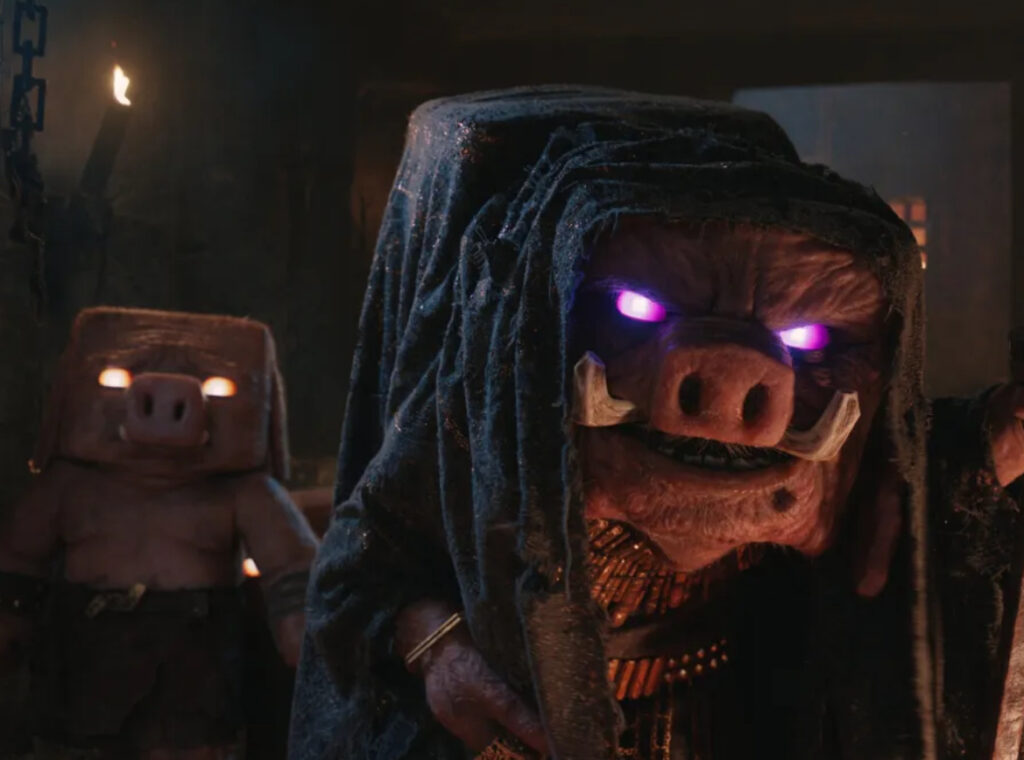In a cinematic landscape saturated with technological spectacle, “A Minecraft Movie” offers something radically counterintuitive — a return to simplicity. But make no mistake: simplicity here is no synonym for ease. Behind its lo-fi, pixelated aesthetic lies some of the most intricate and deliberate visual effects work in recent memory, spearheaded by none other than the legendary Wētā FX. Their secret weapon? A uniquely balanced approach that pays homage to Minecraft’s humble roots while imbuing its blocky universe with grandeur, emotional weight, and character nuance rarely seen in video game adaptations.
At the center of this technical and creative triumph stands Malgosha, the film’s primary antagonist — a figure as menacing, humorous, and strangely tragic as Emperor Palpatine, the iconic villain from “Star Wars.” Modeled both visually and thematically after Palpatine, Malgosha embodies a new standard for character-driven digital antagonists. It is here, in the delicate interplay between restraint and innovation, that Wētā FX reveals its true mastery.
Building a World, One Block at a Time
When Warner Bros. officially greenlit “A Minecraft Movie,” the immediate temptation might have been to overhaul the game’s primitive visuals into a hyper-realistic spectacle. After all, Wētā FX — famous for its groundbreaking work on The Lord of the Rings, Avatar, and The Planet of the Apes franchise — certainly possesses the technical capabilities to push digital realism to staggering heights.
Instead, they made a different choice: stay faithful to the game’s spirit.
Wētā’s creative directors approached the project with a core question: What would Minecraft look like if it obeyed cinematic logic, but retained its soul? Rather than reinvent, they reinterpreted. Every tree, cloud, sheep, and sword remains blocky, rendered with the unmistakable cubic geometry that defines the Minecraft universe. But textures bear minute imperfections — a subtle grain here, a faded pigment there — that create an illusion of tactility and time.
Light behaves differently too. The way a sunset fractures into blocky gradients across the pixelated landscape feels natural, not because it mimics real-world physics, but because it honors the game’s surreal internal logic. Volumetric fog, sparkling oceans, and crumbling fortresses feel alive without ever betraying their source material’s inherent abstraction.
In creating a visually coherent yet cinematically potent world, Wētā FX didn’t just animate blocks; they animated imagination itself.
Animating Emotion in a Blocky Body
Character animation presented perhaps the greatest challenge. Minecraft’s avatars are, by design, minimalistic. Two eyes, a mouth, rigid limbs — not exactly a recipe for expressive acting. Yet Wētā’s animators refused to fall into the trap of overcompensating with excessive motion or slapstick exaggeration.
Instead, they studied the silent-era greats: Chaplin, Keaton, early Disney. How much emotion could be transmitted through timing, through a slight hesitation in a step, a barely perceptible tilt of the head? How could grief, anger, love, or fear be distilled into the most economical physical language?
Malgosha’s creation was the apotheosis of this philosophy. Her design remained fully blocky — no hidden joints, no hidden musculature — and yet through expert animation and sophisticated lighting, her very posture could convey insidious cunning, biting sarcasm, or world-weary resignation.
Her voice, too, followed this minimalist ethos. Voiced by a seasoned actress specializing in Shakespearean tragedy, Malgosha’s dialogue was sparse, deliberate, and weighty — echoing the cadence of Palpatine, but with a distinctly sardonic edge. Every “blocky” facial shift was punctuated by her controlled, mocking delivery, creating a villain as compelling as she was unsettling.
The Influence of Palpatine: Villainy Reimagined
Why Palpatine? Why reach back into the mythos of Star Wars for inspiration in a Minecraft adaptation?
The filmmakers saw a parallel: Minecraft’s deceptively simple world, like Lucas’s original trilogy, masks a deep well of narrative potential. Palpatine worked not because he was flashy, but because he operated on a mythic register — the shadowy manipulator, the decaying symbol of corrupted power.
Malgosha, by contrast, operates within the childlike innocence of Minecraft’s world, but with that same mythic resonance. She is a corrupted ruler of a once-vibrant server, now obsessed with dominion and stasis. Her castle, an enormous obsidian fortress, literally freezes time within its walls — players who enter remain trapped in endless loops, unable to mine, build, or even speak freely.
By crafting Malgosha as a tragic villain — one who fears the loss of creative control more than death itself — the movie introduces a profound tension: in a world built on infinite possibility, the greatest threat is the fear of change.
Lo-Fi Doesn’t Mean Low Effort
One might imagine that building a movie inside a “simple” world like Minecraft would be easier than the photo-realism of Avatar. In truth, it was harder in many ways.
When everything is minimalist, every mistake becomes magnified. A misplaced pixel, an improperly weighted animation, an inconsistent light gradient — all break the spell. Thus, Wētā FX’s craftsmanship had to operate on a razor’s edge. The illusion of simplicity required Herculean effort: hundreds of shaders painstakingly tuned, custom physics engines developed to simulate how blocks collapse, how Redstone contraptions buzz and whir, how lava flows obey slightly exaggerated laws of fluid motion.
Moreover, the team had to simulate entire environmental systems — rainstorms, wind currents, biomes — all within the rigid block structure of Minecraft. A single miscalculation could make a forest fire look either trivial or grotesquely realistic. Striking the right aesthetic tone required continuous iteration and microscopic attention to detail.
Their approach to action sequences reflected this as well. Rather than choreographing fluid martial-arts battles, Wētā leaned into the game’s rhythm. Sword swings are clunky but satisfying; parkour moves feel intentionally stiff but thrilling. It’s a kinetic language that feels faithful to every player who’s ever frantically dodged a Creeper’s blast or built a skybridge under fire.
Embracing the Absurd
An underappreciated aspect of Minecraft’s appeal is its surreal humor. Wētā FX understood this intuitively, allowing moments of absurdity to punctuate the narrative without derailing it.
A zombie pigman getting stuck in a door. A Wither skeleton attempting — and failing — to ride a minecart. Villagers conducting solemn “meetings” over absolutely nothing, punctuated by their trademark “hrrrmm” grunts.
Malgosha herself isn’t exempt from this tonal balancing act. Her malevolent speeches occasionally trail off into comedic frustration when, say, an Enderman steals an artifact mid-monologue, or a redstone trap backfires spectacularly. These moments ground her character, preventing her from tipping into parody while enhancing her tragicomic dimension.
It’s a reminder that Minecraft’s world — like the world of children’s imaginations — contains multitudes: terror and hilarity, wonder and danger, often simultaneously.
The Legacy of Wētā’s Craft
By the time credits roll, “A Minecraft Movie” doesn’t feel like a technological marvel simply for marvel’s sake. It feels like an act of profound artistic empathy.
Wētā FX, in embracing the game’s limitations rather than bulldozing over them, created a cinematic experience that honors what Minecraft has always been: an open-ended invitation to dream. Their work demonstrates that visual effects aren’t about how many polygons you can cram into a frame, or how close to real life you can get. It’s about serving story, emotion, and the ineffable texture of a world.
And in that regard, they have succeeded beyond measure.
Just as Palpatine remains etched in the collective unconscious as a definitive villain for an entire generation, so too may Malgosha carve a place in the hearts of today’s audiences — a tragic, hilarious, chilling reminder that even the simplest worlds can bear the greatest stories.
Impression
In an era obsessed with escalation — bigger explosions, higher frame rates, more hyperrealism — Wētā FX’s work on “A Minecraft Movie” stands as a quiet revolution. It’s a testament to the idea that true mastery lies not in overwhelming audiences with visual noise, but in crafting worlds where imagination can breathe.
Malgosha’s menacing grin, illuminated against a blocky blood-red sunset, says it all. Sometimes, the scariest — and most unforgettable — things are built, quite literally, one block at a time.
No comments yet.








